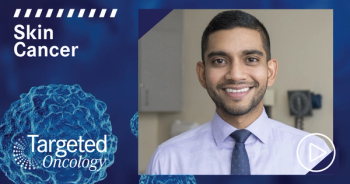
Elucidating a Case of Locally Advanced CSCC
Michael R. Migden, MD:We’re talking here about a 69-year-old male with advanced CSCC [cutaneous squamous cell carcinoma]. This patient had fair skin, was generally healthy, and was retired from construction work where he had a lot of ultraviolet exposure. He was well until he noticed a tender spotbehind his ear—which grew. This was biopsied and found to be a poorly differentiated SCC. On clinical examination, the patient was found to have a 4.5-cm-diameter lesion with erosion that was greater than 5 mm. The pathology showed poorly differentiated CSCC.
The pathology showed a poorly differentiated squamous cell carcinoma, a cutaneous squamous cell carcinoma, with a depth of 7 mm. The patient was recommended to have a partial auriculectomy and radiation. The patient declined. He was started on cemiplimab, 3 mg/kg every 2 weeks.
There wasn’t perineural disease noted on the biopsy, but in this area, you have to wonder if there’s any facial nerve extension through the stylomastoid foramen or whether there’s any interior grade perineural disease. For that reason, you would consider using MRI [magnetic resonance imaging] to detect perineural extent. If you believe that the biopsy didn’t show perineural disease and you don’t need to check for that, a CT [computed tomography] scan would be a faster study that many patients can tolerate better with less artifact.
You can consider doing scouting biopsies, multiple additional biopsies. Since it’s such a large lesion, a single biopsy is subject to a sampling error. Even though there wasn’t perineural disease found in that 1 sample, if you did scouting biopsies throughout the lesion, you might find it, and that would be very helpful to know up front so that you could pick the best imaging modality.
My initial impressions of this case are that you have a tumor that is large in diameter and quite deep. The risk factors include diameter, depth, and poor differentiation. Anything around the ear is a multiple-tissue plane, so it’s a high-risk area for deep extension. There is often potential extent through cranial foramina, such as stylomastoid foramen, so it’s a very high-risk disease.
The ability to remove this surgically could be through temporal bone resection, leading to complete loss of hearing on that side and disfigurement in terms of loss of most or all of an ear. With those considerations, it’s reasonable to think of other optionsso, systemic therapy. The systemic therapy category I would think of would be an anti-PD-1 [anti-programmed cell death protein 1] agent. We could consider cemiplimab as an option.
Transcript edited for clarity.
A 69-Year-Old Man With Advanced CSCC
- History and physical exam
- An otherwise healthy, 69-year-old male, fair skinned, retired construction worker, widow
- Presented to his PCP with what he described as a wound that was not healing behind his ear; he reported first noticing it at least 6 months ago and complained of recent onset of numbness in the area.
- ECOG PS 1
- The visible, ulcerated lesion was 4.5-cm in diameter and >5-mm deep
- No palpable nodes
- Biopsy confirmed a poorly-differentiated, infiltrative, postauricular cutaneous squamous cell carcinoma lesion with 7-mm invasion into subcutaneous fat.
- The recommended definitive surgical approach involved partial auriculectomy; the patient declined.
- Cemiplimab 3 mg/kg q2w was initiated







































